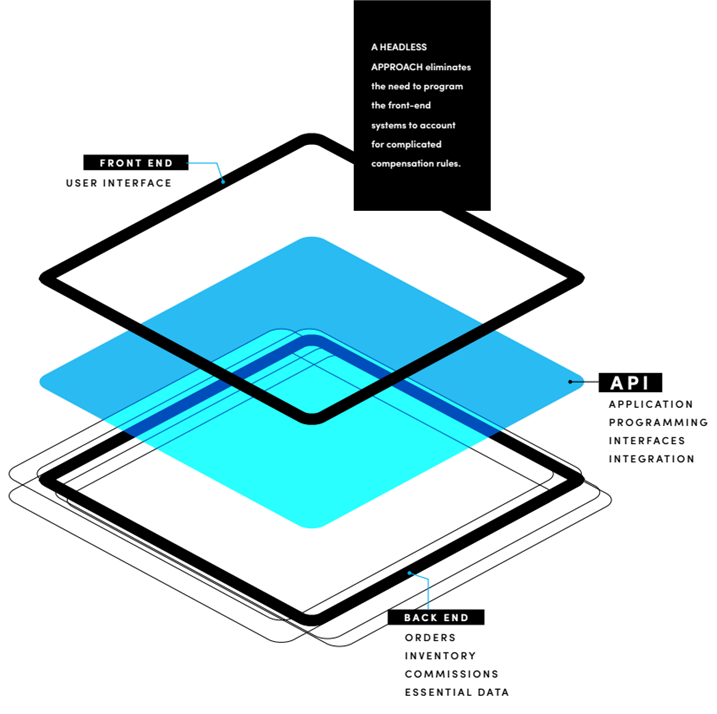In today's ever-evolving technological landscape, it can be difficult for businesses to determine where to direct their IT spend and roadmap. Advancements in technology and new systems can make it a challenge to keep up and remain competitive. However, the rise of headless architecture offers a solution that can help businesses stay ahead of the curve. In this article, we will explore the advantages of headless architecture and how it can benefit companies in the direct selling industry. By understanding the benefits of this technology, businesses can make informed decisions about their IT investments and position themselves for success in the digital age.
Before we go to far, let’s first define what "headless" technology means. It refers to the separation of the front-end, or user interface, from the back-end, or server-side logic, of a web application. For instance, a headless e-commerce system separates the user interface from the back-end, which manages orders, inventory, commissions, and other essential data while these two systems communicate seamlessly through a well-designed API integration.

From the May 2023 issue of Direct Selling News magazine.
Headless systems are especially attractive to companies in unique industries such as Direct Selling. With advancements in compensation platforms, they can consider separating the distributor back office from the back-end systems that store tree and commission data. A headless approach eliminates the need to program the front-end systems to account for complicated compensation rules. Instead, they need to pass unique data to the commission platform and display calculated results provided by the system where earnings or volumes are generated. Removing these calculations from the front-end systems can bring significant improvements in the speed and functionality of the customer experience.
Advantages of Headless E-commerce for Direct Selling Companies
1/ Faster Business Decisions
One of the most significant advantages of headless e-commerce is that it enables Direct Selling companies to bring products to market faster. With the front-end and back-end separated, updates can be made to the user interface without disrupting the back-end system. This means that changes can be made quickly and easily, reducing the time it takes to implement business decisions.
This can be particularly beneficial for Direct Selling companies as product catalogs and promotions change frequently. With a headless system, many of the changes to products or promotions can take place without large development efforts in the front-end display. This modular approach to product, country, and promotion logic can save costs and bring your vision to life faster.
2/ Better User Experience
Headless technology also enables companies to provide a better user experience to their customers. With a decoupled system, companies have greater control over the user interface, allowing them to create unique and personalized experiences for their field. This can be particularly valuable in the Direct Selling industry, where building strong customer relationships has always been the key to success. Additionally, the front-end can be optimized for performance and speed, resulting in faster load times and a smoother overall experience.
This does not just apply to the e-commerce experience. Decoupling the front and back-end systems allows for these same type of optimizations in the back-office, and other customer-facing tools. Partner integrations like mobile apps and training platforms can also benefit from the ability to connect to the same back-end data points your field sees in their main reporting systems. Creating a more congruent experience across your tech ecosystem.
3/ Improved Operational Technology
Another benefit of headless technology is its ability to integrate with other operational systems and platforms. With the front-end and back-end separated, the back-end can be integrated with other technology, such as marketing automation tools, customer relationship management (CRM) systems, and alternative payment gateways. With a traditional web application, integrations often require custom coding and development, which can be time-consuming and expensive. In a headless system, integrations can be done faster using APIs, allowing companies to connect with these other systems and platforms in a more streamlined and efficient way.
4/ Increased Scalability
Headless systems offer increased scalability, which can be a significant advantage for direct selling companies. In a traditional system, every customer interaction with the system has to go through the front-end and back-end systems to reach completion. This can put a tremendous strain on the systems and servers, especially during peak traffic times. With headless systems, the front-end system handles the initial approval of a transaction before handing it off to the back-end system to complete the post-order processes, such as reducing inventory, preparing the order for shipment, or applying commissionable volume. This separation of duties allows customers to see completed transactions without wait times while the back-end system completes post-order processes out of view.
By separating the workload between systems, companies can allocate resources where they are needed most, saving time and money. For example, if a promotion is creating heavy front-end user traffic, additional server capacity can be added to capture the orders, while the processes surrounding shipping or commission calculation take place in the background unfazed by the heavy traffic. Targeting resources where they are needed most prevents oversizing systems and unnecessary spending on unburdened processes.
5/ Future Proof
Technology is advancing rapidly, and it is crucial for companies to keep up with these changes to remain competitive. A decoupled system, like a headless system, can take some of the fear out of technology decisions by creating segments of the system that can be updated or replaced without a company-wide technology overhaul. The versatility to replace just part of a tech stack can give companies a future-proof architecture with the ability to adapt and integrate to the "next big thing."
Direct selling is evolving, and the right technology can help companies lead the way. As companies consider their systems' future, they should consider what a headless architecture can do for their company and field. By using headless systems, companies can achieve increased scalability, allocate resources where they are needed most, and future-proof their technology infrastructure.











